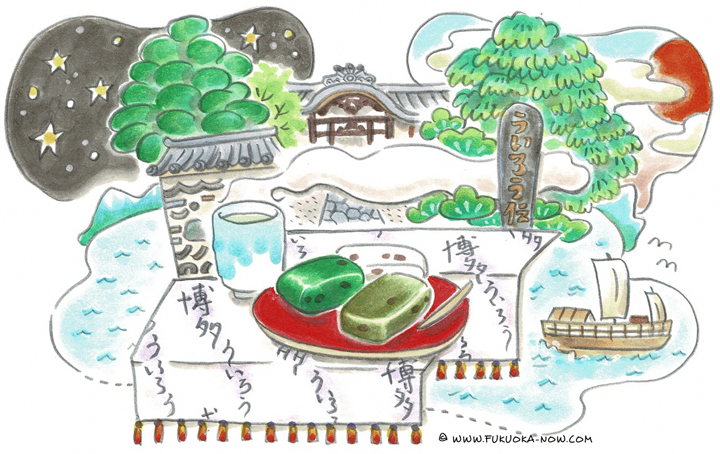Hakata Culture vol.172
Uiro and Myorakuji Temple

Nagoya and Yamaguchi are well-known for the traditional Japanese sweet called uiro, but some believe the chewy steamed cakes originated in Hakata. This is because of a stone monument on the grounds of Myorakuji Temple in Hakata Ward that bears an inscription stating “this is where uiro arrived [from China]”. While the word uiro now refers to the sweet, it used to be a title for a Chinese official.
In 1368, a Chinese uiro named Chen Yanyou (Chin En-yu in Japanese) sought amnesty at Myorakuji Temple in Hakata. Chen, who was well-versed in the healing arts, began selling a medical herb from China, and this medicine came to be known as uiro. Later, his son Soki was invited to Kyoto to serve as the physician for the shogun. He presented the shogun with uiro (the medicine), but the sweets served as a palate cleanser along with the bitter herbs were a hit, and these sweets eventually became what we now call uiro.
Myorakuji Temple was opened in 1316, and its sango (lit. “mountain name”; one part of the official name of a temple) was Sekijozan. This name (literally, “stone castle mountain”) derives from the fact that the temple, which was built atop a stone base on a beach facing Hakata Bay, looked like a stone castle from ships out at sea. It was an important diplomatic hub because it doubled as lodgings for the members of the envoys from Ming dynasty China, and trade with China at that time was so robust it came to be called the Myorakuji trade.
Myorakuji was lost to fire in 1586, and it was relocated to its current site by the Fukuoka Domain early in the Edo era. The temple is home to the tombs of the Kuroda Clan retainers and Sokan Kamiya, an influential Hakata merchant. Although uiro are not very prevalent in Fukuoka now, a local group is trying to make the sweet into a new souvenir. Hakata Uiro are available for sale at Hakatamachiya Furusatokan and other places in the city.
和菓子「ういろう」と妙楽寺
和菓子の「ういろう」は、現在では名古屋や山口の銘菓として有名ですが、そもそものルーツは博多にあったとする説があります。その由来が残されているのが博多区の妙楽寺で、境内には「ういろう伝来之地」と記された石碑が建っています。そもそもの「ういろう」は、現在のような菓子を指す言葉ではなく、中国の役職を表わす外郎(ういろう)という言葉だったといいます。
1368年、中国の外郎職にあった陳延祐が博多の妙楽寺を頼って日本に亡命します。医術に詳しかった陳氏は中国から伝来した薬を販売し、この薬が外郎薬と呼ばれるようになりました。さらに子どもの陳宗奇は京都へ招かれて将軍に仕える医師となり、外郎薬を献上しましたが、苦い薬の口直しに添えていた菓子が評判となり、やがてこの菓子が「ういろう」と呼ばれるようになったのです。
1316年開山の妙楽寺は、山号を石城山(せきじょうざん)といいます。創建当時、妙楽寺は博多湾岸の沖の浜にあり、浜辺の石塁の上に築かれた堂々とした建物が、海上から見るとまるで石城のように見えたことにちなんだものです。遣明使一行が宿泊するなど重要な外交使節のひとつであり、当時は「妙楽寺貿易」と呼ばれるほど中国と盛んに貿易が行われていました。
妙楽寺は1586年に一度焼失しますが、江戸時代に入ると福岡藩によって現在地に移転されます。境内には黒田家家臣の墓や博多の豪商である神屋宗湛の墓が残されています。ところで、博多ではあまり見かけない「ういろう」ですが、妙楽寺にちなんで「ういろう」を博多の新しい銘菓にしようという動きがあります。「博多ういろう」は博多町家ふるさと館などで販売しています。

